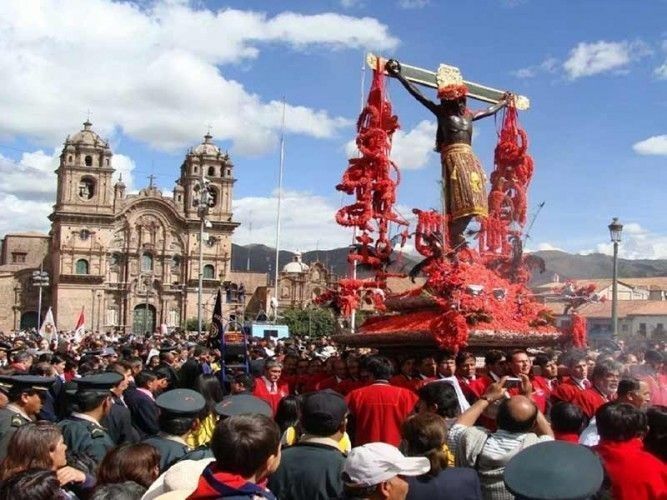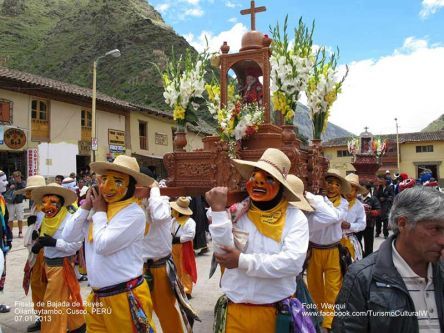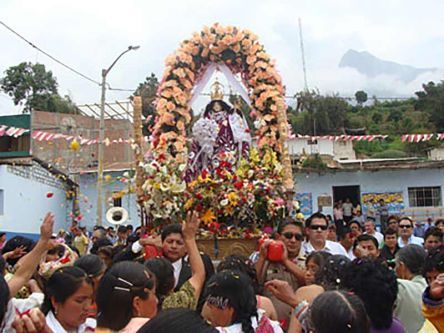Around the globe the celebration of Easter, so the commemoration of Jesus’s crucifixion, burial and resurrection from the dead, is the most important festivity in the yearly calendar for Christians; Peru, where over 80% of the population is catholic and another more or less 12% evangelic protestant, is no exception.
While celebrations in some Peruvian cities and communities are more enthusiastic than in others, generally the festivities are a quite traditional affair with some ancient customs mixed in.
The Easter bunny, dyeing, painting and decorating Easter eggs, egg hunts and Easter fires however are usually not part of how Peruvians celebrate Easter; even though in recent years some of these western traditions here and there swashed to Lima and you can find some Easter goodies on sale in supermarkets or your children might decorate some Easter eggs in one of the international schools.
Easter is a lovely time in Peru with lots of local traditions, worshipping, eating, spending time with family and within the community, dancing and music while celebrating faith.
The Semana Santa (the Holy Week) starts on Domingo de Ramos (Palm Sunday), so the Sunday before Easter Sunday, commemorating Jesus’ entry into Jerusalem. Believers attend a mass some with crosses made of palm leaves. In some communities, the front doors are blessed afterwards.
Jueves Santo (Holy Thursday) and Viernes Santo (Good Friday) are public holidays in Peru.
On Holy Thursday the priests wash the feet of twelve elders during a special mass commemorating Jesus’ washing the feet of the twelves Apostles and the Last Supper of Jesus Christ with them, as described in the canonical gospels. The faithful in Peru visit 7 churches on Holy Thursdays, representing the Stations of the Cross. People in Peru come together and eat twelve different local dishes, usually six savory and six sweet meals, remembering the Last Supper.
Mourning Jesus’ crucifixion Good Friday in Peru is a quiet day and allows time for reflection. There are masses and processions around Peru. Traditionally on this day fish is eaten. Popular are, for example, the famous Chupe de Viernes (Friday Soup), a hearty fish soup, Ceviche, other fish soups and fried fish dishes. No alcohol is consumed.
On Sabado de Gloria, Holy Saturday, believers still mourn and commemorate Jesus’ burial. After nightfall, however, the Easter Vigil is celebrated and the faithful chant and celebrate.
Domingo de Resurrección or Pascua (Easter Sunday), the central day of the Easter festivities in Peru, is characterized by overall celebrations in and outside of church commemorating Jesus’ resurrection from the dead. Festivities take place around the country with lots of local food and drinks, music and dancing and here and there parades.
Easter in Ayacucho
Ayacucho, located high in the Peruvian Andes, has the largest and most enthusiastic religious celebrations, especially during the Semana Santa, when thousands of faithful people visit the city. Famous for its 33 churches, one for each year of Jesus’ life, the Easter celebrations begin on the Friday of Sorrows, the Friday before Palm Sunday, with a huge procession in honor of “Our Lady of Sorrows”.
On Palm Sunday Jesus’ entry into Jerusalem riding on a mule is recreated while thousands of believers along the way wave with palm leaves. Each following day until Easter there is a procession or other religious event. On Wednesday, for example, the meeting of Jesus with his mother is reenacted at Ayacucho’s main square, while on Holy Thursday the faithful visit seven churches. Jesus' death is mourned on Good Friday and after sunset a candlelight procession accompanied by masses of faithful chanting and praying roam through the streets of Ayacucho.
After so much grieving, the town changes completely on Holy Saturday. At 09.00 am the bells of the 33 churches ring announcing the resurrection of Jesus Christ. Now there is no stopping the crowds. Everywhere in town there are festivities and people celebrate. There are food and craft fairs, folkloric dances and music, concerts and partying until the dawn of Easter Sunday.
Easter in Cusco - El Señor de los Temblores celebration
Cusco celebrates the Holy Week and Easter traditionally. However, the most important day of the celebrations is Lunes Santo, Holy Monday - not as often said Easter Monday, the day after Easter Sunday, but the Monday after Palm Sunday.
On March 31, 1650 Cusco was hit by a long earthquake with a magnitude of around 7.5. The tremor caused heavy damages to many buildings in the city and affected big parts of central and south Peru. It is reported that up to 5000 people lost their life. But when the citizens of Cusco took a statue of Christ on the Cross out of the cathedral, the shaking suddenly stopped and an even worse disaster was prevented.
Since that day the faithful venerate the statue of Christ on the Cross as El Señor de los Temblores (the Lord of the Earthquakes) and believe their adoration protects them from earthquakes. Each year on Holy Monday after a special mass in the morning with lots of praying and chanting, the image is taken out of Cusco’s cathedral in the afternoon.
Decorated with red ñucchu flowers that in ancient times were used as an offering to the Inca gods Kon and Wiracocha - by the way the cathedral in Cusco was built on the site of their temple - but since Christianization symbolize Jesus’ blood which he shed for us for the remission of our sins, El Señor de los Temblores is carried around the center of Cusco in a large procession.
And while this procession at first glance seems to be a truly Christian affair, it as well keeps ancient traditions of the Incas and other pre-Hispanic cultures alive. These held similar processions to appease the deities causing earthquakes and paraded the mummies of their leaders, chiefs and high-priests around town. So, the festivities in honor of El Señor de los Temblores on Monday of the Holy Week are as so many other religious celebrations in Peru a merging of Christian traditions brought to the country by the Spanish conquerors with the ancient customs and beliefs of native cultures.
Anyway, accompanied by Quechua singers and a massive crowd that throws more ñucchu flowers along the way, the statue of the Lord of the Earthquakes, which is blackened from centuries of soot of oil lamps and candles, pigment and pollen of the red flowers and dirt, visits other churches of town during the more or less 6 hour procession before returning to Cusco’s cathedral in the evening.
Easter in Huaraz
Easter celebrations in Huaraz high in the Peruvian Andes are a super traditional affair with a different procession each day of the Holy Week and lots of especially national tourists visiting during that time.
The festivities begin on Palm Sunday with a re-enactment of Jesus’ entry into Jerusalem. El Señor de Ramos is taken in a procession through the streets of Huaraz in the morning. Around noon, the Sanctuary of Soledad is reached where a large mass is celebrated.
A highlight of the Holy Week in Huaraz is the procession on Good Friday that starts on 02.00 am at the Church of Soledad and reenacts the journey of Jesus of Nazareth crucifixion.
On Easter Sunday there are two processions starting from different parts of town: the one of Jesus and the one of Mary. Both meet at the main square of Huaraz where Jesus’s resurrection from the dead is reenacted and mother and son reunite. Fireworks end the Easter celebrations.
Easter in Lima
Easter in Peru’s capital is a quite quiet affair. As Easter marks the end of summer in Lima, everybody who can, leaves town for Semana Santa or at least for the long weekend (Holy Thursday and Good Friday are public holidays), either to visit family in the provinces, to make a camping trip or to enjoy the beaches in the south one last time before the grey and humid winter returns.
It is common that those faithful who stayed in Lima visit 7 churches on Holy Thursday and take Holy Water from these churches in small bottles with them. With over 20 churches only in the historic city center, a straightforward task. On the Easter weekend there is a large procession in honor of the Virgin Mary and Jesus of Nazareth through the center of Lima and, of course, masses throughout Holy Week.
Easter in Arequipa
Arequipa mainly follows the traditional Easter celebrations we described above. The major celebration, however, takes place on Easter Sunday when a large image of Judas is burnt symbolically punishing him for his betrayal. The day ends with huge fireworks illuminating Peru’s second largest city and of course lots of local food and drinks.






























